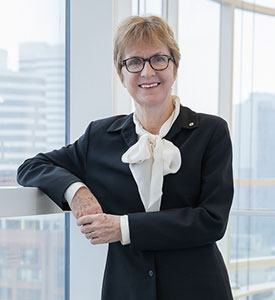Realizing the Promise of Stem Cell Research

Courtesy of the Gairdner Foundation.
CIHR Foundation Grant Recipient
Dr. Janet Rossant
Hospital for Sick Children
University of Toronto
Dr. Rossant’s Research
For Dr. Janet Rossant, it’s an exciting time to be a stem cell researcher. After decades of research on the fundamental properties of stem cells, scientists are now approaching a moment when therapies seem close at hand.
Dr. Rossant, a researcher at the Hospital for Sick Children in Toronto, has made important contributions to what we know about stem cell biology and embryo development, and she has helped make Canada a leader in stem cell research. She has uncovered how stem cells are created within embryos, and what gives them their special ability to turn into any cell in the body – a characteristic known as pluripotency. She has also been a leader in the field of mouse “mutagenesis” – developing methods of systematically disrupting genes in the mouse genome to help understand their function.
In 1993, Dr. Rossant and her colleague Dr. Andras Nagy demonstrated that embryonic stem cells are fully pluripotent – meaning that they have the ability to turn into any cell in the body – by making embryonic stem cell-derived mice.
In addition, she has explored the potential treatment applications of her findings. She and her team showed that it was possible to create lung cells with the mutation for cystic fibrosis (CF) from stem cells – an advance that could be tremendously useful for identifying the best treatment for individual CF patients, and other drug discovery applications.
“Looking at cells from the patient will give us a much better idea of how well a treatment will work for that person,” said Dr. Rossant.
Supporting Advances in Stem Cell Research
Researchers have learned a lot about embryonic development over the years, but questions still remain. For example, researchers don’t fully understand the signals that control the development of an embryo and the formation of stem cells. Cells in the early embryo must make a series of “decisions” that will guide their development and determine what type of cell they will become in the body. Cracking this code would help us understand why embryos sometimes fail during the early stages of pregnancy, bring us closer to new stem-cell based treatments for a wide variety of illnesses, and improve researchers’ abilities to create stem cells. It could also help researchers develop better ways of testing new medications in the lab.
With her Foundation grant, Dr. Rossant will help address some of these unanswered questions. She will continue to improve our understanding of the signals that control embryo development, so that researchers can improve their ability to derive stem cells to treat diseases. She will also be looking at trophoblasts – cells in the embryo that form the placenta – to determine how they develop, and how this knowledge could help improve fertility treatments. Finally, Dr. Rossant and her team will be continuing their work to develop patient-specific lung cells to improve the development of new treatments for lung diseases, such as CF.
“We now have the tools to really understand the signals that control the development of embryos and stem cells. We can now study any developmental system, and use this knowledge to make any kind of cell.”
About Dr. Rossant
Dr. Rossant has led a major CIHR-funded initiative for genome-wide mutagenesis (the study of the functions of genes) in mice. She also co-led Canada’s contribution to the International Knock-Out Mouse Consortium. Dr. Rossant established the Toronto Center for Phenogenomics – a research facility known as “The Mouse House” – which produces mice with specific gene mutations for researchers around the world, and conducts extensive studies on gene function. In addition, in her role as Director of the Ontario Institute for Regenerative Medicine, Dr. Rossant helps bring together researchers, clinicians, engineers and industry partners to advance stem cell research. She received the Michael Smith Prize from CIHR in 2005, and the March of Dimes International Prize in Developmental Biology in 2007. She is a Fellow of the Royal Societies of London and Canada, and a Foreign Associate of the National Academy of Science USA. In 2015, she received the Gairdner Wightman Award for her contributions to science and the Canadian health research environment.
- Date modified: